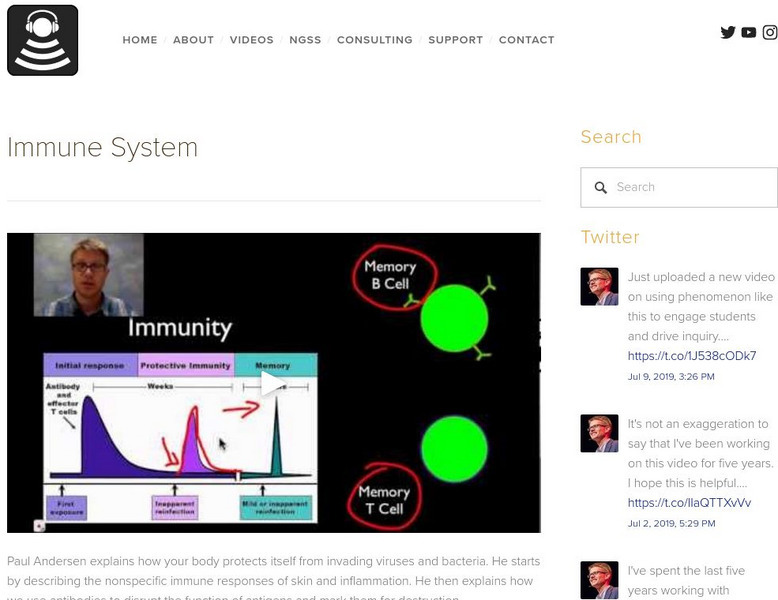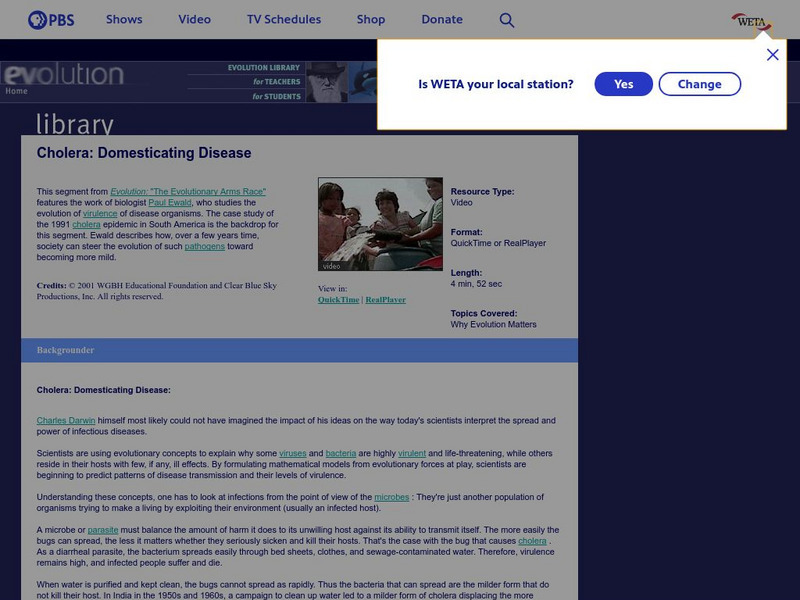FuseSchool
How are Pathogens Spread and Controlled?
How can we stop the tiny terrors that cause illness? Junior epidemiologists examine the methods used to control the spread of pathogens with a video from from a biology playlist. The narrator describes the benefits of hygiene,...
FuseSchool
What Are Vaccinations?
Are vaccinations necessary in preventing illness? As part of a larger playlist, a short, yet informative video describes what vaccines are and how they work in the body. Viewers witness the introduction of the vaccine culture and how the...
MinuteEarth
How Your Dog Can Protect You Before You're Born
Are there things mothers can do to prevent their unborn children from having asthma? It turns out the answer is related to the household pets. The video explains how dogs and cats seem to protect the health of babies and children. It...
Crash Course
Community Ecology II: Predators
The first examples of mimicry we have found date back to before flowering plants. The video goes in depth on predators at the community ecology level. It includes discussions of herbivores, parasitism, adaptations, cryptic coloration,...
SciShow
How To Make Antivenom
You are nine times more likely to die from a lightning strike than a snakebite, thanks to anti-venom. But where does anti-venom come from? Viewers follow the process of making anti-venom, beginning with the discovery of how to make it...
Howard Hughes Medical Institute
How We Get Our Skin Color Interactive
I can see your epidermis. A short video shows how we get our skin color. It explains how melanocyte cells in the epidermis produce melanin, and that the type and amount of melanin controls skin color.
Howard Hughes Medical Institute
Hhmi: Bio Interactive: Size Analogies of Bacteria and Viruses
Comparisons of bacteria and viruses with standard cells. [1:43]
Next Vista for Learning
Next Vista for Learning: Bacteria Defending the Body
A video showing a white blood cell defending the body against a virus. Also learn that red blood cells function to bring oxygen throughout the body. [1:35]
PBS
Pbs Learning Media: Bubonic Plague
In this video segment adapted from A Science Odyssey, learn about bubonic plague and how city officials in San Francisco tried to contain its spread in the early 1900s. [5:06]
PBS
Pbs Learning Media: Liquid Assets: Public Health
This video segment from a WPSU documentary Liquid Assets connects public health to the availability of clean and safe drinking water and elaborates on the threats our bodies face due to increasing kinds and quantities of pollutants.
Bozeman Science
Bozeman Science: Immune System
Paul Andersen explains how your body protects itself from invading viruses and bacteria. He starts by describing the nonspecific immune responses of skin and inflammation. He then explains how we use antibodies to disrupt the function of...
Khan Academy
Khan Academy: What Is Pneumonia?
Pneumonia is a medical condition where lung tissue becomes inflamed, usually caused by a virus or bacteria. Learn how shortness of breath, cough, and fever are common symptoms of this condition and why they occur in pneumonia.
PBS
Pbs Learning Media: The Discovery of Penicillin
This video segment adapted from A Science Odyssey tells the story of researcher Sir Alexander Fleming, whose luck and scientific reasoning led to the groundbreaking discovery of penicillin. [4:45]
PBS
Pbs Learning Media: Producing Penicillin
In this video segment adapted from A Science Odyssey, follow two scientists and their Nobel Prize-winning efforts to cure bacterial infections using penicillin. [4:54]
PBS
Pbs Kids: Dragonfly Tv: The Show: Glo Germ
Is there a way to avoid spreading germs to our friends and families? Come along with Jordan and Sydney as they research this topic.
Bozeman Science
Bozeman Science: Viral Replication
Paul Andersen explains how viruses reproduce using the lytic cycle. He also shows how viruses can pick up new genetic material and how retroviruses (like HIV) can enter into the lytic cycle. He also describes the lysogenic cycle and how...
Kurzgesagt
You Tube: Kurzgesagt: Why You Are Still Alive the Immune System
Every second of your life you are under attack. Bacteria, viruses, spores and more living stuff wants to enter your body and use its resources for itself. The immune system is a powerful army of cells that fights like a T-Rex on speed...
California Academy of Sciences
Ca Academy of Sciences: Cow Power
Why not use micro-organisms (bacteria, viruses, fungus, etc.) to create sustainable energy and fuel? There are a lot of ideas currently being researched and put to use including turning cow manure into natural gas. [4:43]
PBS
Pbs Teachers: Cholera: Domesticating Disease
Discover how scientists are beginning to predict patterns of disease transmission and levels of virulence. Explore how society can steer the evolution of microorganisms to weaken them.
PBS
Pbs Teachers: Evolution of Antibiotic Resistance
Explore how antibiotics help some sick people. Discover what happens when patients cut short their full course of antibiotic drugs.
Other popular searches
- Bacteria and Virus
- Fungi Bacteria and Virus
- Bacteria and Virus Crossword
- Bacteria and Virus Test
- Bacteria Virus
- Biology Bacteria and Virus
- Bacteria Virus Protist
- Fungus Bacteria Virus
- Bacteria and Virus Video
- Bacteria and Virus Review
- Bacteria and Virus Anatomy
- Biology Virus Bacteria

















